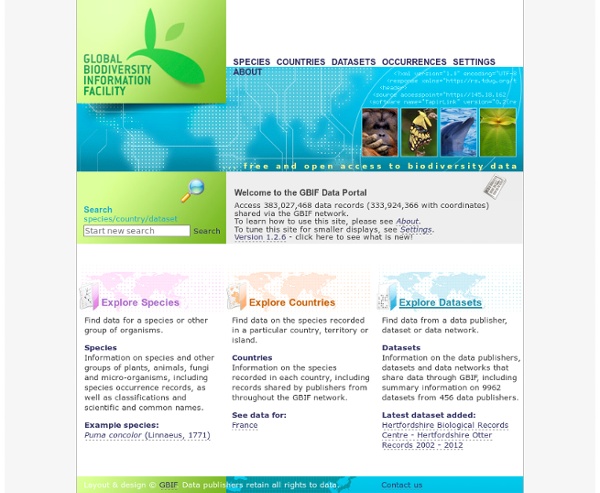HOME
Search Form: World List of Marine, Freshwater and Terrestrial Is
Excel Download Help Information After clicking on the link to the Excel download, you should get a window like this one: Click on the Save button and save it to wherever you want on your local computer. When you open up the Excel file you will get a message box like this one: Click Yes. Please be patient with the process of downloading the full list and opening up the file.
Homepage Nationaal Herbarium Nederland
Search FishBase
Associated Journal Publish in our journal partner Acta Ichthyologica et Piscatoria the results of your primary research on fishes about growth, weight-length relationships, reproduction (maturity, fecundity, spawning), food and diet composition, introductions and range extensions for faster subsequent entry in (2011 impact factor: 0.547). Indexed Journal Cybium (publisher: SFI, Société Française d’Ichtyologie) For journal editors: Would you wish that your journal were indexed in FishBase, please contact our librarian. References Citing FishBase How to cite FishBaseTo give due credit to the original authors, please cite data taken from FishBase by Main Ref. and/or Data Ref. of the respective record. Cite FishBase itself asFroese, R. and D. DisclaimerFishBase present information on fishes as correctly as possible. Copyright This work is licensed under a Creative Commons Attribution-Noncommercial 3.0 Unported License.
Welcome to ZipcodeZoo
Crustacea, Natural History Museum of Los Angeles County
Contact Information Dr. Joel (Jody) Martin, Curator of Crustacea & Division Chief DIS (213) 763-3440jmartin@nhm.org Adam Wall, Assistant Collections Manager (213) 763-3450awall@nhm.org Museum Scientists on Evolution The Natural History Museum, with its mission to inspire wonder, discovery, and responsibility, recognizes that evolutionary biology is fundamental to understanding biological diversity and is critical for both scientific research and museums. To see our Evolution Statement in full, click here Crustacea Department The Museum's collections of Crustacea are the second largest in the United States and the fourth largest in the world. Our collections are also worldwide in scope with broad representation from the Indian, Pacific, and Antarctic oceans, as well as the Caribbean Sea.
CBS fungal Biodiversity centre: Home
Catalogue of Life - 3rd February 2012 :: Search all names
Wikispecies, free species directory
MycoBank, the fungal website
Video: At 800 Pounds and 45 Feet Long, The Largest-Ever Paper Airplane Takes Flight
Arturo Valdenegro, 12-year-old Tucson resident, made paper aviators everywhere look minuscule by comparison last week. In the skies over the Sonora desert in Arizona, the Pima Air & Space Museum launched the biggest paper airplane ever constructed--a paper airplane based on Valdenegro's design--into the sky, accelerating it to speeds topping 100 miles per hour before it came crashing down (as paper airplanes do). The plane, aptly named Arturo's Desert Eagle, weighed 800 pounds and stretched 45 feet long with a 24-foot wingspan. The museum constructed it out of falcon board, a kind of corrugated cardboard, as part of its Giant Paper Airplane Project, the goal of which is to generate interest in aviation and engineering among young people. Arturo designed and folded his plane for the competition, winning top honors in a fly-off sponsored by the Pima museum. But for last week's flight, his design was adopted and constructed by Art Thompson, one of the designers of the B-2 stealth bomber.
Earth
Earth is the third planet from the Sun. It is the densest and fifth-largest of the eight planets in the Solar System. It is also the largest of the Solar System's four terrestrial planets. Earth formed approximately 4.54 billion years ago, and life appeared on its surface within its first billion years.[24] Earth's biosphere then significantly altered the atmospheric and other basic physical conditions, which enabled the proliferation of organisms as well as the formation of the ozone layer, which together with Earth's magnetic field blocked harmful solar radiation, and permitted formerly ocean-confined life to move safely to land.[25] The physical properties of the Earth, as well as its geological history and orbit, have allowed life to persist. Name and etymology The modern English noun earth developed from Middle English erthe (recorded in 1137), itself from Old English eorthe (dating from before 725), deriving from Proto-Germanic *erthō. Composition and structure Shape Heat Surface
PERSOONIA - Molecular Phylogeny and Evolution of Fungi
Biology
History The objects of our research will be the different forms and manifestations of life, the conditions and laws under which these phenomena occur, and the causes through which they have been effected. The science that concerns itself with these objects we will indicate by the name biology [Biologie] or the doctrine of life [Lebenslehre]. Although modern biology is a relatively recent development, sciences related to and included within it have been studied since ancient times. Natural philosophy was studied as early as the ancient civilizations of Mesopotamia, Egypt, the Indian subcontinent, and China. However, the origins of modern biology and its approach to the study of nature are most often traced back to ancient Greece.[6] While the formal study of medicine dates back to Hippocrates (ca. 460 BC – ca. 370 BC), it was Aristotle (384 BC – 322 BC) who contributed most extensively to the development of biology. Foundations of modern biology Cell theory Main article: Cell theory Genetics



